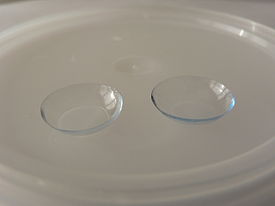
Back عدسات لاصقة Arabic Контактна леща Bulgarian Lent de contacte Catalan Kontaktní čočka Czech Kontaktlinse Danish Kontaktlinse German Φακός επαφής Greek Kontaktlenso Esperanto Lente de contacto Spanish Kontaktläätsed Estonian


Contact lenses, or simply contacts, are thin lenses placed directly on the surface of the eyes. Contact lenses are ocular prosthetic devices used by over 150 million people worldwide,[1] and they can be worn to correct vision or for cosmetic or therapeutic reasons.[2] In 2010, the worldwide market for contact lenses was estimated at $6.1 billion, while the US soft lens market was estimated at $2.1 billion.[3] Multiple analysts estimated that the global market for contact lenses would reach $11.7 billion by 2015.[3] As of 2010[update], the average age of contact lens wearers globally was 31 years old, and two-thirds of wearers were female.[4]
People choose to wear contact lenses for many reasons.[5] Aesthetics and cosmetics are main motivating factors for people who want to avoid wearing glasses or to change the appearance or color of their eyes.[6] Others wear contact lenses for functional or optical reasons.[7] When compared with spectacles, contact lenses typically provide better peripheral vision, and do not collect moisture (from rain, snow, condensation, etc.) or perspiration. This can make them preferable for sports and other outdoor activities. Contact lens wearers can also wear sunglasses, goggles, or other eyewear of their choice without having to fit them with prescription lenses or worry about compatibility with glasses. Additionally, there are conditions such as keratoconus and aniseikonia that are typically corrected better with contact lenses than with glasses.[8]
- ^ R Moreddu; D Vigolo; AK Yetisen (2019). "Contact Lens Technology: From fundamentals to Applications" (PDF). Advanced Healthcare Materials. 8 (15): 1900368. doi:10.1002/adhm.201900368. PMID 31183972. S2CID 184488183.
- ^ NM Farandos; AK Yetisen; MJ Monteiro; CR Lowe; SH Yun (2014). "Contact Lens Sensors in Ocular Diagnostics". Advanced Healthcare Materials. 4 (6): 792–810. doi:10.1002/adhm.201400504. PMID 25400274. S2CID 35508652.
- ^ a b Nichols, Jason J., et al "ANNUAL REPORT: Contact Lenses 2010". January 2011.
- ^ Morgan, Philip B., et al. "International Contact Lens Prescribing in 2010". Contact Lens Spectrum. October 2011.
- ^ Agarwal, R. K. (1969), Contact Lens Notes, Some factors concerning patients' motivation, The Optician, 10 January, pages 32-33 (published in London, England).
- ^ Sokol, JL; Mier, MG; Bloom, S; Asbell, PA (1990). "A study of patient compliance in a contact lens-wearing population". CLAO Journal. 16 (3): 209–13. PMID 2379308.
- ^ "Compare Contacts & Glasses". ACUVUE® Middle East. Retrieved 22 November 2021.
- ^ "Contact Lenses for Keratoconus". National Keratoconus Foundation. 21 February 2018.
© MMXXIII Rich X Search. We shall prevail. All rights reserved. Rich X Search